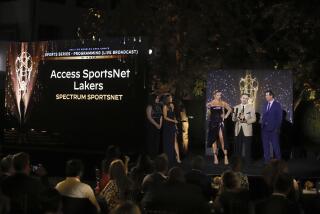Quake Coverage Lasts Too Long on Channel 4
- Share via
Even though Channel 5 went back to regularly scheduled programming at noon and Channel 2 went to golf shortly after that, Channel 4 chose to stay with earthquake coverage until 1 o’clock Sunday.
That decision meant that the first television appearance of the U.S. Olympic men’s basketball team, the “Dream Team,” was delayed one hour in Los Angeles.
After the station received about 100 calls from complaining viewers, news anchor John Beard announced at about 12:45 that the station would switch to the basketball at 1 p.m.
“I know a lot of you want to see the basketball, and so do I,” Beard told viewers.
Channel 4, to its credit, picked up the basketball coverage from the top, rather than joining it in progress. Had the station done that, only the second half would have been shown.
But there seemed to be no apparent reason for Channel 4 to stay with earthquake coverage for that extra hour, because there was nothing new to report.
The smart thing, it seems, would have been to cut off the coverage at noon, then break into the basketball game if necessary.
“We made the determination to stay on with earthquake coverage until 1 p.m.,” station spokeswoman Regina Miyamoto said, “because we felt there was important information to get out to the community.”
Channel 4 did get one break. It was an off day at Wimbledon, so no live action was preempted.
What the rest of the country got, mostly, was taped coverage of last week’s John McEnroe-Pat Cash match.
Also included in the Wimbledon coverage was a taped interview with Arthur Ashe, who talked with Bud Collins and Dick Enberg about how he is dealing with life since it became public knowledge that he has AIDS.
Ashe said his anger toward the media about how the story came out has subsided, partially because he has been treated well by the media in general since then.
Channel 4 dispatched news reporter Rick Chambers to Dodger Stadium, which wasn’t a bad idea.
But Chambers missed the mark when he tried to compare the atmosphere at Dodger Stadium to the one at Candlestick Park during the 1989 World Series.
When the Bay Area earthquake hit, the stadium was full. Dodger Stadium was empty when Sunday’s quakes occurred. Big difference.
Channel 4 turned sportscaster Fred Roggin into a news reporter. He reported on downed power lines in Studio City at about 6:30 a.m.
Channel 2 not only switched over to sports programming at the right time, it was also the first L.A. station to go on the air with news of the earthquake.
Reporter Jodi Baskerville rushed in from her home in Toluca Lake and was on camera at 5:13 a.m., 15 minutes after the first earthquake hit.
It was a busy day for Baskerville. She anchored the initial coverage from the Channel 2 studio in Hollywood, later reported live from Yucca Valley and then came across the crash of a light aircraft at Lake Arrowhead shortly after it happened.
Radio beat: KMPC, which dropped the ball when the rioting broke out on April 29, two days after it went to its new sports format, reacted well this time, as it did when the Angel bus crashed May 21.
Overnight hosts Don and Rick Shaw were preparing to go off the air Sunday morning at 5 a.m. and give way to public-access programming when the first quake hit. So they stayed on the air, taking calls until 7 a.m.
Weekend reporter Ted Sobel then took over for an hour until Geoff Witcher and Steve Yeager went on at 8 a.m., an hour earlier than scheduled.
Witcher and Yeager talked so much about the earthquakes that Witcher dubbed the show “Earthquake ’92.” Problem was, the callers’ personal stories got a little old after a while.
San Diego-based XTRA basically stuck with its regular sports programming.
More to Read
The complete guide to home viewing
Get Screen Gab for everything about the TV shows and streaming movies everyone’s talking about.
You may occasionally receive promotional content from the Los Angeles Times.






